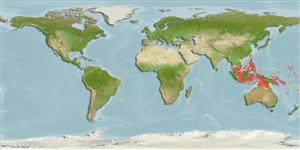Environment: milieu / climate zone / depth range / distribution range
Ecología
marino asociado a arrecife; rango de profundidad 30 - 70 m (Ref. 90102). Tropical
Distribución
Países | Áreas FAO | Ecosistemas | Ocurrencias, apariciones | Point map | Introducciones | Faunafri
Western Central Pacific: Brunei Darsm, Indonesia, Papua New Guinea and Philippines.
Tamaño / Peso / Age
Maturity: Lm ? range ? - ? cm
Max length : 12.0 cm TL macho / no sexado; (Ref. 48635)
Espinas dorsales (total) : 10; Radios blandos dorsales (total) : 13 - 15; Espinas anales: 3; Radios blandos anales: 7.
A deep water species, forming small aggregations with large coral heads at the base of deep slopes in current prone areas. Usually in depths of 40+ m depth (Ref. 48635). Often in silty conditions, in 30-70 m (Ref 90102).
Life cycle and mating behavior
Maturities | Reproducción | Spawnings | Egg(s) | Fecundities | Larva
Heemstra, P.C. and J.E. Randall, 1999. Serranidae. p. 2442-2547. In K.E. Carpenter and V.H. Niem (eds.) FAO species identification guide for fishery purposes. The living marine resources of the Western Central Pacific. Vol. 4. Bony fishes part 2 (Mugilidae to Carangidae). Rome, FAO. 2069-2790 p. (Ref. 39231)
IUCN Red List Status (Ref. 130435)
Threat to humans
Harmless
Human uses
Herramientas
Special reports
Download XML
Fuentes de Internet
Estimates based on models
Preferred temperature (Ref.
123201): 26.2 - 28.3, mean 27.4 °C (based on 84 cells).
Phylogenetic diversity index (Ref.
82804): PD
50 = 0.5000 [Uniqueness, from 0.5 = low to 2.0 = high].
Nivel trófico (Ref.
69278): 3.4 ±0.4 se; based on size and trophs of closest relatives
Resiliencia (Ref.
120179): Alto, población duplicada en un tiempo mínimo inferior a 15 meses (Preliminary K or Fecundity.).
Fishing Vulnerability (Ref.
59153): Low vulnerability (10 of 100).
